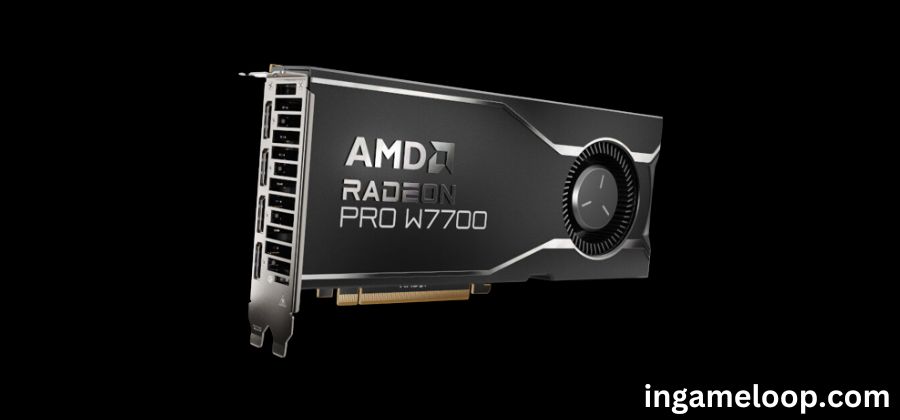
AMD has officially introduced the Radeon Pro W7700 16GB at the Supercomputing 2023 conference. This marks a significant milestone for AMD as the company unveils its first Navi 32-based workstation GPU, catering to professionals with a keen eye on performance and affordability. Priced at $999, the Radeon Pro W7700 is poised to make waves in the market, offering a compelling alternative to its competitors.
As a dedicated workstation GPU, the Radeon Pro W7700 commands a higher price point compared to consumer-grade graphics cards. AMD, however, seeks to justify this premium with a promise of superior performance and finely tuned drivers tailored for professional workloads. The unveiling has not been without its challenges, as AMD navigates the intricate landscape of nomenclature. With the existence of the W7800 professional part, the company has christened its latest offering the W7700, a move that speaks to the intricacies of product positioning in a competitive market.

Delving into the technical specifications, the Radeon Pro W7700 mirrors the core capabilities of the Radeon RX 7800 XT, a consumer-grade counterpart that costs half as much. Despite this parallel, the W7700 sets itself apart with drivers optimized for professional applications. A noteworthy aspect of the W7700 is its utilization of Navi 32, a departure from the larger Navi 31 GCD found in the W7800. This strategic choice allows AMD to offer a compelling product at the enticing $999 price point.
In terms of memory, the Radeon Pro W7700 presents an intriguing balance between performance and capacity. Sharing the same memory bandwidth as the W7800, it opts for a more economical 16GB capacity compared to the W7800’s 32GB. This decision, while reducing the overall memory capacity, enables AMD to offer a competitively priced alternative without compromising on essential features.
AMD wasted no time in drawing comparisons with its perennial rival, Nvidia, emphasizing the superior performance of the W7700 at a lower price point. Benchmark comparisons, notably SPECviewperf, showcase the W7700 outperforming previous-generation Nvidia parts, including the 4000 SFF Ada. This not only underlines AMD’s commitment to providing value but also positions the W7700 as a formidable contender in the professional GPU market.
However, the comparison is not without its caveats. One area where AMD lags is power efficiency. The 4000 SFF Ada, with a mere 70W power requirement, significantly outshines the W7700’s 190W consumption. While this power delta is less pronounced against Nvidia’s previous generation A5000, A4500, and A4000, the omission of Nvidia’s newer RTX 5000, 4500, and 4000 parts from the comparison raises eyebrows.
AMD’s decision to adopt a single GDDR6 chip per MCD has implications for memory capacity, eroding the typical advantage seen in consumer-grade GPUs. The W7800’s 32GB capacity, achieved with two 2GB chips per MCD, is halved in the W7700. Despite this, AMD’s tests indicate that the W7700 holds its ground, outperforming the Nvidia A5000 in SPECviewperf and showcasing a notable lead in individual tests, with Siemens NX being a noteworthy exception.
Beyond raw performance metrics, the Radeon Pro W7700 brings advanced connectivity options to the table. Boasting four DisplayPort 2.1 UHBR13.5 ports at 54 Gbps each, it outshines competitors like the W7800 and W7900, which feature a single UHBR20 port (80 Gbps) alongside three UHBR13.5 ports. This technological advantage positions the W7700 as a forward-looking solution, catering to professionals who demand cutting-edge connectivity. The AMD Radeon Pro W7700 16GB emerges as a compelling addition to the professional GPU landscape. With its strategic pricing, balanced performance, and forward-looking features, it sets a new standard for affordability without compromising on the demands of professional workloads. As AMD continues to challenge the status quo, the W7700 is poised to carve a significant niche in the market, providing professionals with a powerful and cost-effective solution for their graphic-intensive endeavors.
Related:
AMD Launches EPYC 8004-Series ‘Siena’ CPUs: Up to 64 Zen 4c Cores
AMD graphics card users report gremlins with Windows 11
AMD Radeon RX 7600 XT With 16GB VRAM Expected In 2024
AMD Extends 3rd Gen EPYC ‘Milan’ Availability, Adds New Models







